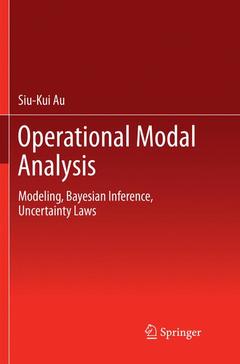Operational Modal Analysis, Softcover reprint of the original 1st ed. 2017 Modeling, Bayesian Inference, Uncertainty Laws
Auteur : Au Siu-Kui

Dr. Au is Professor of Uncertainty, Reliability & Risk in the Center for Engineering Dynamics and Institute for Risk & Uncertainty, University of Liverpool (UK); and Chutian Professor in the School of Water Resources & Hydropower Engineering, Wuhan University (China). He holds a PhD (2001, Caltech) in civil engineering and has been working in the area of the monograph for over twenty years. He performs fundamental and applied research in engineering risk methods and structural health monitoring. He has developed an advanced Monte Carlo method called Subset Simulation that has found applications in many disciplines, e.g., civil, mechanical, aerospace, electrical and nuclear engineering. He is experienced in full-scale dynamic testing of structures and has consulted on vibration projects on long-span pedestrian bridges, large-span floors, super-tall buildings and micro-tremors. Dr. Au is recipient of the IASSAR Junior Research Prize (2005), Nishino Prize (2011), JSPS Fellowship (2014) and Tan Chin Tuan Fellowship (2015).
Presents operational modal analysis, employing a coherent and comprehensive Bayesian framework for modal identification
Download the dataset to the book on https://doi.org/10.7910/DVN/7EVTXG
Covers materials from introductory to advanced level, which are classified accordingly to ensure easy access for readers from different fields
Includes stochastic modeling, theoretical formulations, computational algorithms, and practical applications
Includes supplementary material: sn.pub/extras
Date de parution : 12-2018
Ouvrage de 542 p.
15.5x23.5 cm
Date de parution : 07-2017
Ouvrage de 542 p.
15.5x23.5 cm



